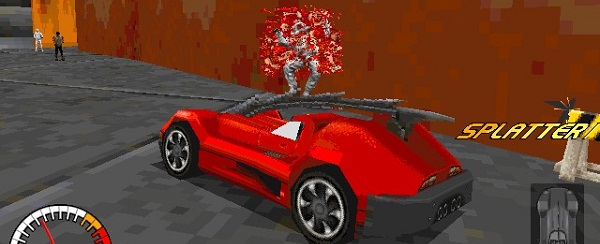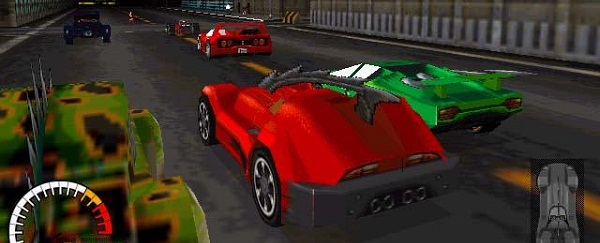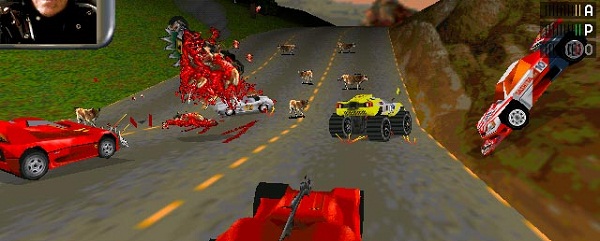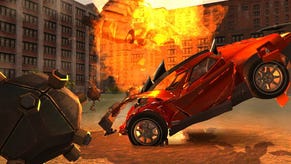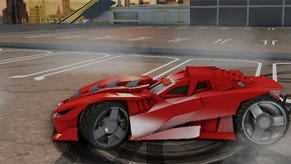Gaming Made Me: Carmageddon
Likewise Twisted
I was nine years old, visiting far-flung relatives in Malaysia. Back then, piracy was huge over there, with entire shops in respectable shopping malls dedicated purely to the sale of pirated software of all stripes. To a young kid with no real concept of money and ownership, all I saw was shelves of games in poorly-photocopied plastic wallets that my well-meaning relatives happily bought for me, armfuls at a time. Though their behaviour was confusing, I wasn’t about to stop them and I hurried along, pulling game after ill-gotten game into a small pile of treasure. Then, on one rack near the back, a single image stood out: a bald man daubed in blood with eyes like the devil clutching a steering wheel, and stamped with a big, fat, deliciously intoxicating 18 Certificate.
I knew it must have been a racing game, that much was obvious. As a child, racing games weren’t just my favourite genre, they were the only type of game I ever played. The concept of one that was 18 rated didn’t make any sense – how could that work? Flipping the case over, I was confronted with a series of screenshots showing dark cities, burning cars and the bloody mess of the pedestrians in their way. What looked like monster trucks, dragsters and sports cars affixed with spikes and ramrods all racing at once, seemingly with the intent of total destruction. I immediately know that I had to have it. I snuck it into the pile of games already chosen, and hoped that my smiling relatives wouldn’t see.
Now, I wouldn’t say that I was a completely innocent child, but I was definitely unprepared for what came next. After flying back home to England, I guiltily loaded it up on the wheezing family Gateway P166 when my parents were out and was confronted with this:
I’m pretty sure I suffered from nightmares because of that. For a kid whose entire music experience so far was listening to The Beach Boys and The Beatles in his Dad’s car, the devil drums of an instrumental Fear Factory song coupled with the seemingly wanton murder of an innocent flag man was too much to bear. Still, it didn’t exactly dissuade me from playing. Like an addict, once exposed to the carnage I kept on returning again and again.
And it’s here where Carmageddon began to have its effect on me. I started to realise that it wasn’t an excruciating horror game designed to terrify me, but instead was it meant to be a joke. Having never been exposed to any kind of black humour before, playing Carmageddon was a concentrated exposure to a very adult sense of cynicism and bad taste. Coupled with a child’s sense of obsession, I quickly started having my own private education by playing it after coming home from a day of Key Stage 2 at the local primary school.
I began seeing the humour in the writing and character design, but much of it still was flying stratospherically over my head (only getting a Cunning Stunt bonus in later teenage years). Nevertheless, I took the game extremely seriously, playing it with the solemnity usually reserved for studying high works of literature. I agonised over every detail about the world before me, as almost every idea was new to me. The fact of a near-future urban dystopia, for instance – that was something I had simply never encountered before. The races set in and around the MagnaChem Acid Ocean Reprocessor especially electrified my imagination: a huge industrial structure surrounded by an endless acid yellow ocean. Was this the blue sea I swam in? How did it become like this? What on earth had happened to this world?
Previous racing games I had played around with existed only in the current world of rally cars and Ferraris, or if set in the future, they only showed the clean neon dreams of Wipeout or the fluffy chaos of Rollcage. Carmageddon’s future was bleak and dismal, the primitive draw distance giving a constant atmosphere of polluted depression simply by fogging up the road ahead. It got me interested in environmental awareness, encouraged me to start reading science fiction and propelled me into overly dramatic teenage years mired in cyberpunk and metal culture, all because of how seriously I was taking an immature racing game designed to make tabloid headlines.
Of course I was quickly found out by my parents, who surprisingly enough only reinforced the “no games until you finish your homework” rule. I began showing it to my friends from school, and the gratuitous violence and lurid depravity captivated our impressionable minds, bringing forth hurried lunchtime sessions of drawing the cars exploding out of our imaginations onto the 1cm squared graph paper.
Playing it now reveals a somewhat muted experience, a combination of sluggish steering and lethargic gravity conditions resulting in a staid, almost conservative time at the race track. The feel of the game is stilted. Nevertheless, there’s no denying that developers Stainless Games achieved something special with the encapsulating technology and world design, letting you loose in giant maps to make your own free-roaming fun. What other racing game has taken such a care-free approach to victory conditions? This was a game that counted laps and rank positions, yet didn’t care if you turned right around and didn't drive near a single checkpoint. Victory came through destroying the competition as often as coming first.
In fact, the game all but compelled you to drive off-course, the official race layout each time a mere suggestion. Stainless seemed to be perfectly happy fostering a rich sense of exploration, creating entire cities and coastal towns before sprinkling a handful of directions as a casual afterthought. Even progression through the race championship was non-linear, letting you choose which tracks to race with many of them optional, dependent on your whims. Carmageddon was a game designed with every aspect on an eye to empower the player, all the usual restrictions gone. Getting lost was all part of the ride.
Ludicrous events could happen as a result. Though the steering might have been spongy, the cars had no such problems with straights, and were in fact probably more overpowered than the design merited. The sportier ones felt as if they reached almost supersonic speeds down the longer stretches of highway, inevitably hitting a yellow and black barrier placed square in the middle of the road and being catapulted so high into the air that the draw distance would erase the tops of the skyscrapers below you, leaving you momentarily floating in the ether, trapped in one of those existential grey nightmares peculiar to late-90s 3D action games.
Carmageddon had an innate surrealism that fascinated me, featuring powerups like the Instant Hand Brake which would immediately stop you cold and worked even in mid air, or the Wall Climbing Ability that let you effortlessly scale cliff walls. They all instilled a madcap atmosphere that is still at odds with many of today's po-faced racers. The madness would only deepen in the later Splat Pack expansion, which drove even further off track and offered twisted worlds comprised of eerie broken bridges connecting unreal floating islands. Not to mention a final level that featured a race through a fiery burning Hell, complete with miniature disco and a giant Satan playing Carmageddon on a huge beige desktop PC. It’s places like this that filled my daydreams and doodles at school above any other fictional playground.
The damage model of the cars was likewise twisted. Fully destroyable cars with detachable parts were torn apart with glee in the later sequel Carpocalypse Now, but Carmageddon had no such luxuries. Instead, damage was shown by warping the very vehicle models themselves, and taking a drive through one of the many minefields reduced your car into what looked like a stuttering graphical error, a jagged mess of warped polygons and stretched textures hobbling around on a fractured wheelbase. It makes the destruction seen in modern racing games seem twee in comparison – really, what are Burnout’s engine blocks made from that they can withstand that kind of punishment as the chassis shreds like tin foil? I used to bend and twist the Carmageddon garage into unrecognisable shapes with glee; the canned destruction seen these days is toothless for all its sound and fury.
Embarrassingly enough, this isn't the first time I've stood up and tried to explain why I loved this game so much to an audience. One week in primary school, we had a class project on how to give presentations. We could choose our topic, and had to spend five minutes in front of the class attempting to sound professional. Inevitably, I chose Carmageddon, and after a couple of evenings of tense preparation, I stood up in front of my childhood peers and stammered my way through the appeal of an 18 rated videogame. It was my first foray into games journalism, and it didn't exactly go well. I can see a lot of myself today in that kid, forever trying to make people understand his passion about a topic that frequently resembles the very depths of unsophisticated puerile entertainment, only to have blank stares of silent pity reflected back at him.
Stainless recently made some noise with their reacquiring of the Carmageddon license, announcing a downloadable sequel dubbed Reincarnation, slated for a 2012 release. There's precious little information available at the moment, save for this interview by Alec, the official website containing community-made papercraft cars and a smattering of concept art (which admittedly all makes me preposterously excited). I'm comically eager to find out any new information, though I have reservations over the base humour on display and what that means for the eventual game. I've long since realised that being offensive for the sake of being offensive isn't exactly something to be celebrated.
Carmageddon's presentation was unashamedly crass and unsophisticated, admired by me only as a child because I’d never experienced bad taste humour before. However, playing it also filtered my perception of the world as I was growing up, helped foster young friendships that continue to reward to this day, and cemented strong feelings about the role of games as cultural and social tools that are the reasons I’m compelled to write today.
Carmageddon was by no means a perfect game. It just happened to be the perfect game for me.


